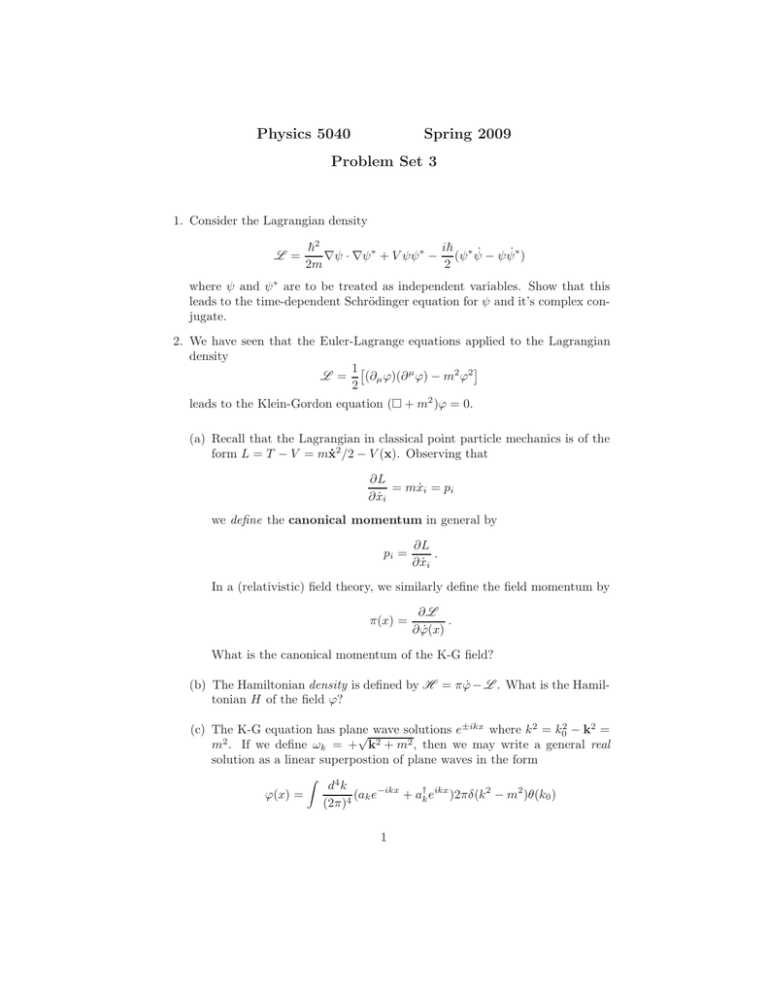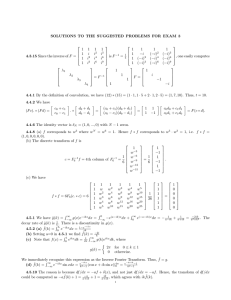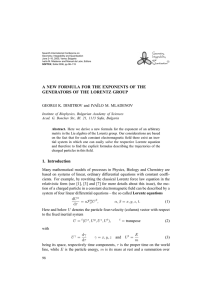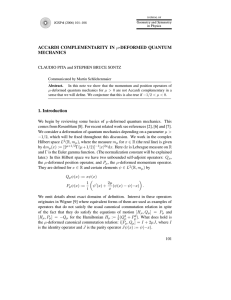Physics 5040 Spring 2009 Problem Set 3
advertisement

Physics 5040 Spring 2009 Problem Set 3 1. Consider the Lagrangian density L = ~2 i~ ∇ψ · ∇ψ ∗ + V ψψ ∗ − (ψ ∗ ψ̇ − ψ ψ̇ ∗ ) 2m 2 where ψ and ψ ∗ are to be treated as independent variables. Show that this leads to the time-dependent Schrödinger equation for ψ and it’s complex conjugate. 2. We have seen that the Euler-Lagrange equations applied to the Lagrangian density 1 L = (∂µ ϕ)(∂ µ ϕ) − m2 ϕ2 2 leads to the Klein-Gordon equation ( + m2 )ϕ = 0. (a) Recall that the Lagrangian in classical point particle mechanics is of the form L = T − V = mẋ2 /2 − V (x). Observing that ∂L = mẋi = pi ∂ ẋi we define the canonical momentum in general by pi = ∂L . ∂ ẋi In a (relativistic) field theory, we similarly define the field momentum by π(x) = ∂L . ∂ ϕ̇(x) What is the canonical momentum of the K-G field? (b) The Hamiltonian density is defined by H = π ϕ̇ − L . What is the Hamiltonian H of the field ϕ? ±ikx (c) The K-G equation has plane where k 2 = k02 − k2 = √ wave solutions e 2 2 2 m . If we define ωk = + k + m , then we may write a general real solution as a linear superpostion of plane waves in the form Z d4 k ϕ(x) = (ak e−ikx + a†k eikx )2πδ(k 2 − m2 )θ(k0 ) (2π)4 1 where the step function θ(k0 ) is required to avoid double counting in the R integral d4 k over all space, and ak , a†k are hermitian conjugate expansion coefficients. This form is really telling you that in the exponentials we have k0 = ωk . Consider the factor d4 k 2πδ(k 2 − m2 )θ(k0 ) . (2π)4 Since Lorentz transformations are orthogonal (i.e., ΛT gΛ = g so that det Λ = +1 for proper transformations), it follows that d4 k is unchanged under a Lorentz transformation (i.e., the Jacobian of the transformation is just 1). It is also obvious that k 2 − m2 is unchanged under a Lorentz transformation since both k 2 and m2 are Lorentz scalars. Furthermore, a proper orthochronous Lorentz transformation can’t change the sign of k0 . This is easiest to see from the basic equation ∆t′ = γ(∆t − β∆x). Since β < 1 and ∆x < ∆t, we must have ∆t′ > 0 if and only if ∆t > 0. Therefore the above factor is manifestly Lorentz invariant. Show that Z d3 k d4 k = 2πδ(k 2 − m2 )θ(k0 ) . 4 (2π)3 2ωk k0 (2π) Because of this, the term d3 k (2π)3 2ωk is referred to as the invariant volume element. Note that the numerical factors aren’t necessary to maintain invariance. R (d) By considering the integral f (p) = d3 q δ(p − q)f (q) (where p2 = q 2 = m2 ), argue that (2π)3 2ωp δ(p − q) is also Lorentz invariant. (This is called the invariant delta function.) (e) We may now write Z d3 k ϕ(x) = (ak e−ikx + a†k eikx ) . (2π)3 2ωk If we let fk (x) = e−ikx [(2π)3 2ωk ]1/2 then we have ϕ(x) = Z d3 k [fk (x)ak + fk∗ (x)a†k ] . [(2π)3 2ωk ]1/2 2 Define an “inner product” on functions f (x), g(x) by Z ← → hf (x), g(x)i := d3 x f ∗ (x)i∂0 g(x) := Z d3 x f ∗ (x)[i∂0 g(x)] − [i∂0 f ∗ (x)]g(x) where ∂0 = ∂/∂x0 = ∂/∂t. Show that Z ← → d3 x fk∗ (x)i∂0 fk′ (x) = δ(k − k′ ) while Z 3 d ← → x fk∗ (x)i∂0 fk∗′ (x) = Z ← → d3 x fk (x)i∂0 fk′ (x) = 0 . In other words, the functions fk (x) form an orthonormal set with respect to the above inner product. (f) Show that ak = Z ← → d3 x [(2π)3 2ωk ]1/2 fk∗ (x)i∂0 ϕ(x) a†k Z ← → d3 x [(2π)3 2ωk ]1/2 ϕ(x)i∂0 fk (x) . and = (g) So far all of this has applied to a classical field. We go over to a quantum field by analogy with ordinary quantum mechanics where we have (with ~ = 1) the operator commutation relations [xi , pj ] = iδij . Thus we require the equal time canonical commutation relations [ϕ(x, t), π(y, t)] = iδ(x − y) and [ϕ(x, t), ϕ(y, t)] = [π(x, t), π(y, t)] = 0 . Show that these relations imply [ak , a†k′ ] = (2π)3 2ωk δ(k − k′ ) and [ak , ak′ ] = [a†k , a†k′ ] = 0 . This shows that the coefficients ak and a†k become the annihilation and creation operators of a harmonic oscillator. Thus the field ϕ(x) acts to annihilate and create quanta with 4-momentum k µ . 3 (h) Let us now write ϕ(x) = Z d3 k (ak e−ikx + a†k eikx ) (2π)3 2ωk := ϕ+ (x) + ϕ− (x) where ϕ (x) = Z d3 k ak e−ikx (2π)3 2ωk ϕ− (x) = Z d3 k a† eikx . (2π)3 2ωk k + and are referred to as the positive and negative frequency parts of ϕ(x). Show that Z d3 k + − e−ik(x−y) := i∆+ (x − y) [ϕ (x), ϕ (y)] = (2π)3 2ωk where ∆+ (x − y) is the same function defined in Exercise 15 of Problem Set 1. This shows how the Green’s function arises in a natural way in quantum field theory. 3. We have seen that the rotation operator for a vector in R3 can be written in the form R(θ) = eθ·J . Now let’s take a look at how the spatial rotation operator is defined in quantum mechanics. If we rotate a vector x in R3 , then we obtain a new vector x′ = R(θ)x where R(θ) is the matrix that represents the rotation. In two dimensions this is ′ x cos θ − sin θ x = . y′ sin θ cos θ y If we have a scalar wavefunction ψ(x), then under rotation we obtain a new wavefunction ψR (x′ ), where ψ(x) = ψR (x′ ) = ψR (R(θ)x). (See the figure below. This is for an active transformation.) ψR (x′ ) x′ ψ(x) θ x Alternatively, we can write ψR (x) = ψ(R−1 (θ)x). 4 Since R is an orthogonal transformation (it preserves the length of x) we know that R−1 (θ) = RT (θ), and in the case where θ ≪ 1 we then have x + θy R−1 (θ)x = . −θx + y Expanding ψ(R−1 (θ)x) with these values for x and y we have ψR (x) = ψ(x + θy, y − θx) = ψ(x) − θ[x∂y − y∂x ]ψ(x) or, using pi = −i∂i this is ψR (x) = ψ(x) − iθ[xpy − ypx ]ψ(x) = [1 − iθLz ]ψ(x). For finite θ we exponentiate this to write ψR (x) = e−iθLz ψ(x), and in the case of an arbitrary angle θ in R3 this becomes ψR (x) = e−iθ·L ψ(x) . This was for spatial rotations. In general, for a particle with total angular momentum J (where [Ji , Jj ] = iεijk Jk ) we define the rotation operator to be R(θ) = e−iθ·J . In the particular case of a spin one-half particle we have J = S = σ/2 where the Pauli matrices σ are defined by 0 1 0 −i 1 0 σ1 = σ2 = σ3 = 1 0 i 0 0 −1 and obey the commutation relations [σi , σj ] = 2iεijk σk . (a) Show that the Pauli matrices obey the relations σi σj = iεijk σk for i 6= j and [σi , σj ]+ := σi σj + σj σi = 2Iδij and hence that we also have the very useful result σi σj = Iδij + iεijk σk . (b) Show that for any vectors a and b we have (a · σ)(b · σ) = (a · b)I + i(a × b) · σ . 5 (c) Show that the rotation operator for spin one-half particles is given by e−iθ·σ/2 = I cos = " θ θ − i(σ · θ̂) sin 2 2 cos θ/2 − iθ̂3 sin θ/2 −iθ̂− sin θ/2 −iθ̂+ sin θ/2 cos θ/2 + iθ̂3 sin θ/2 # where θ̂± = θ̂1 ± iθ̂2 . 4. In Problem 2 you looked at some properties of the real Klein-Gordon field which describes neutral scalar particles (i.e., spinless neutral particles). In this problem you will look at some properties of the complex Klein-Gordon field which, as you will see, describes charged spinless particles. So, consider the Lagrangian density L = ∂µ ϕ† ∂ µ ϕ − m2 ϕ† ϕ where I have written ϕ† rather than ϕ∗ because we will be treating the fields ϕ as quantum mechanical operators rather than simply complex classical fields. (a) Treating ϕ and ϕ† as independent fields, what are the corresponding equations of motion for this Lagrangian density? What are the canonical momenta π and π † ? (b) Now observe that this Lagrangian density is invariant under the global phase transformation ϕ(x) → ϕ′ (x) = e−iΛ ϕ(x) and † ϕ† (x) → ϕ′ (x) = eiΛ ϕ† (x) where Λ ≪ 1 is a constant. Then we know that there exists a conserved current j µ with ∂µ j µ = 0 and where jµ = ∂L ∆ϕr − T µ α δxα ∂ϕr,µ with ∆ϕr (x) = δϕr (x) + ∂µ ϕr (x)δxµ and T µα = ∂L ϕr,α − δαµ L . ∂ϕr,µ What is the conserved charge Q= Z j 0 (x) d3 x ? Note that any overall factor of the constant Λ can be dropped from Q since d(ΛQ)/dt = 0 implies that dQ/dt = 0 also. 6 (c) Following exactly the same approach as we did for the real K-G field, we expand the complex fields as Z d3 k ϕ(x) = ak fk (x) + b†k fk∗ (x) [(2π)3 2ωk ]1/2 and † ϕ (x) = Z d3 k † ∗ b f (x) + a f (x) k k k k [(2π)3 2ωk ]1/2 where we write fk∗ (x) for the complex conjugate of the ordinary function fk (x), and a†k for the “complex conjugate” (i.e., the adjoint) of the quantum mechanical operator ak . We have labelled the expansion coefficients of the positive and negative frequency parts by ak (resp. bk ) and b†k (resp. a†k ) because the fields are complex so there is no requirement that ak and b†k be complex conjugates of each other. We have added the dagger on bk because with hindsight we know that it behaves as a creation operator. We now impose the canonical equal time commutation relations (ETCR’s) on the fields: [ϕ(x, t), π(y, t)] = [ϕ(x, t), ϕ̇† (y, t)] = iδ(x − y) and [ϕ† (x, t), π † (y, t)] = [ϕ† (x, t), ϕ̇(y, t)] = iδ(x − y) and where all other commutators vanish. Show that [Q, ϕ(x)] = −ϕ(x) and [Q, ϕ† (x)] = +ϕ† (x) . Hint : Recall the commutator identity [ab, c] = a[b, c] + [a, c]b. To help understand what these mean, let |qi be an eigenstate of Q, so that Q|qi = q|qi. Then Qϕ|qi = ϕ(Q − 1)|qi = (q − 1)ϕ|qi and hence ϕ decreases the eigenvalue of |qi by one. Similarly, Qϕ† |qi = ϕ† (Q + 1)|qi = (q + 1)ϕ† |qi and therefore ϕ† increases the eigenvalue of |qi by one. (d) Solving for the coefficients ak , a†k , bk , b†k as we did in the real case, we can then use the ETCR’s to finally show that (after a lot of algebra which wouldn’t hurt you to work out for yourself) [ak , a†k′ ] = [bk , b†k′ ] = (2π)2 2ωk δ(k − k′ ) and [ak , bk′ ] = [ak , b†k ] = 0 . 7 Thus we see that both a†k and b†k create harmonic oscillator quanta. Show that Q= Z d3 k † a ak − b†k bk − (2π)3 2ωk δ(0) . (2π)3 2ωk k Dropping the infinite constant (2π)3 2ωk δ(0), we see that Q represents the total number of a quanta minus the total number of b quanta, and hence Q is essentially just the total charge operator. 8







